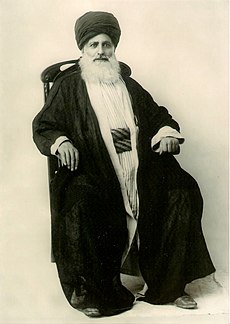Al-Sayyed Mohsen al-Amin (b.1284 A.H./1867 C.E. - d.1371 A.H. /1952 C.E.), also transliterated Muhsin al Amin, was a Shia scholar, biographer, traditionist, and jurist. He was born in Jabal Amil, Lebanon. His most important work is A'yan al-Shi'a.[1]
Al-Sayyed Mohsen al-Amin | |
|---|---|
 Grand Ayatollah Al-Sayyed Mohsen al-Amin | |
| Born | 1867 |
| Died | 1952 |
| Region | Southern lebanese Scholar |
| School | Shia Twelver |
Early life and education
editFamily background
editAl-Amin was born in 1867 to a well-known Sayyid family in Jabal Amil, Lebanon. His father, Abdul al-Karim al-Amili, was a scholar of his time. His father died in Iraq was buried, when he had gone to pilgrimage in Iraq.[2] His maternal grandfather was ′Shaykh Muhammad Hussein al Amili al Musawi, was one of the scholars who went to Najaf for education and died there.[2]
Education
editSayyed Mohsen began to study the Qur'an and elementary Arabic grammar at the age of seven under a village teacher.[2] Four years later, he learned jurisprudence for three years under Shaykh Musa Sharara who returned to Iraq. In 1890, arrangements were made for him to study in Najaf, Iraq.[2] Finally he was a learned Mujtahid.[3]
Activity
editHe was among the first Shi’i modernists and received widespread condemnation by the Shia community of Lebanon for his endeavours in attempting to change and reform the religion, particularly when it came to issues of tatbir, which he was against.
His children
editPublished works
edit- Ayan al-Shia (Arabic: أعيان الشيعة), is one of his works. This work the biographical encyclopedia book[6] and consists of fifty-six volumes.[2]
- Al-husun al-mani'a fi radd ma awradahu sahib al-manar fi haqq al-shia (Arabic: الحصون المنیعة فی ردّ ما اورده صاحب المنار فی حقّ الشیعة), he explained some of the Shia views in this book.[7]
- Risalat al-tanzih li-a'mal al-shabih (Arabic: رسالة التنزيه لاعمال الشبيه), that was al-Amin's reply to his critics-Sadiq.[3]
- Al-Sahifa al-Sajjadiyya al-khamisa (Arabic: الصحيفة الخامسة السجادية) is the longest version of the Sahifa of al-Sajjad has been published.[8][9]
- Al-Majalis al-saniyya fi manaqib wa-masa'ib al-'itra al-nabawiyya (Arabic: المجالس السنيه في مناقب و مصائب العتره النبويه)[10]
- Iqna' al-la'im ala iqamat al-matam (Arabic: اقناع اللائم علی اقامه المآتم)[10]
- Lawa'ij al-ashjan fi maqtal al-imam Abi Abd Allah al-Husayn (Arabic: لواعج الأشجان في مقتل الإمام إبي عبد الله الحسين ابن علي بن أبي طالب عليه السلام)[10]
- Kashf al-Irtiyab fi Atba' Muhammad b. 'Abd al-Wahhab (Arabic: كشف الإرتياب في أتباع محمد بن عبد الوهاب) [11]
See also
editReferences
edit- ^ "Al-Sayyid Muhsin al-Amin". WikiShia. December 10, 2014. Retrieved May 2, 2015.
- ^ a b c d e Ajami, Fouad (April 2012). The Vanished Imam: Musa al Sadr and the Shia of Lebanon. Cornell University Press (August 25, 1987). ISBN 978-0801494161.
- ^ a b Chalabi, T. (6 February 2006). The Shi'is of Jabal 'Amil and the New Lebanon: Community and Nation-State, 1918–1943. Palgrave Macmillan; 1st edition (February 22, 2006). ISBN 978-1403970282.
- ^ Shaery-Eisenlohr, Roschanack (2008). Shi'ite Lebanon: Transnational Religion and the Making of National Identities (History and Society of the Modern Middle East). Columbia University Press (July 3, 2008). p. 224. ISBN 9780231144261.
- ^ Abisaab, Abisaab, Rula Jurdi, Malek (9 December 2014). The Shi'ites of Lebanon: Modernism, Communism, and Hizbullah's Islamists (Middle East Studies Beyond Dominant Paradigms). Syracuse University Press; Reprint edition (January 20, 2017). p. 57. ISBN 978-0815635093.
{{cite book}}: CS1 maint: multiple names: authors list (link) - ^ Pourjavady, Reza (November 2018). Philosophy in Qajar Iran. BRILL (November 8, 2018). p. 87. ISBN 978-9004385610.
- ^ Brunner, Rainer (2004). Islamic Ecumenism in the 20th Century: The Azhar and Shiism Between Rapprochement and Restraint (Social, Economic and Political Studies of the Middle East and Asia). Brill (October 28, 2004). ISBN 978-9004125483.
- ^ "Translator's Introduction". al-islam.
- ^ "Al-Sahifa al-Sajjadiyya (The Psalms of Islam)". hajij.
- ^ a b c Shams ad-Din Al-Amili, Shaykh Muhammad Mahdi. "The Revolution of Imam al-Husayn (a)". Muhammadi Trust of Great Britain and Northern Ireland.
- ^ Brockelmann, Carl (10 July 2018). History of the Arabic Written Tradition Supplement Volume 3 - i (Handbook of Oriental Studies. Section One: The Near and Middle East / History of the ... Tradition) (English and Arabic ed.). BRILL; Supplement edition (July 19, 2018). ISBN 978-9004335813.
Sources
edit- Fouad Ajami. The Vanished Imam: Musa Al Sadr and the Shia of Lebanon. Ithaca: Cornell University Press, 1986.